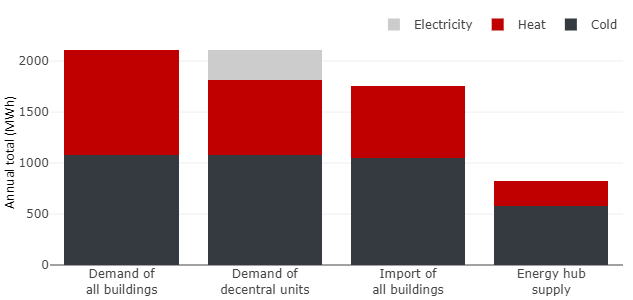Balancing of heating and cooling demands in 5GDHC networks
One advantage of 5GDHC networks (anergy networks) is that they can provide heating and cooling. This also leads to a partial balancing of heating and cooling demands within a district.
How does the balancing of heating and cooling demands work in 5GDHC networks?
For districts with a 5GDHC network, two balancing effects can be distinguished: On the one hand, heating and cooling demands that occur in one building at the same time can be balanced (demand balancing in the building). On the other hand, heating and cooling demands that occur in different buildings can be balanced by the 5GDHC network (demand balancing between buildings). The basic principle is the same in both cases: waste heat from the cold supply can be used as a heat source at the evaporator of the heat pump. In this way, on the one hand, the waste heat does not have to be dissipated (recooling) and, on the other hand, less external heat has to be provided for the evaporator of the heat pump.
Demand balancing in buildings
In buildings, heating and cooling demands can be balanced if they occur simultaneously. For cooling, either a heat exchanger can be installed or a chiller. In both cases, a waste heat flow is generated, which can be partially or completely used by the heat pump (at the evaporator). In this way, the waste heat that is fed into the 5GDHC network and the heat that is drawn from the 5GDHC network are reduced. As a result, at a given time, either only surplus heat is fed into the 5GDHC network or only heat is drawn from the network.
Demand balancing between buildings
If at a given time at least one building feeds heat into the 5GDHC network and at least one other building draws heat from the network, there is a balancing between buildings. In the case of a perfect balance, the heat quantities fed in and drawn are equal in total across all buildings. In this case, no mass flow would pass through the energy hub and the district would be completely thermally balanced. However, this ideal case occurs only at a few points in the year. Usually, only a part of the heating or cooling demands in the districts is directly balanced and the rest must be covered by the energy hub.
Example calculation in nPro
The balancing of heating and cooling demands in 5GDHC networks can be evaluated and visualized in nPro. The graph showing the balancing in 5GDHC networks in the nPro tool will be explained using the following example: A 5GDHC network supplies a residential building complex (10,000 m²) and a data center (average waste heat output of 100 kW). Figure 1 visualizes the demand balancing in different parts of the system.

The first column demand of all buildings shows the total heating and cooling demands of all buildings (space heating, domestic hot water and space cooling for the residential building and process cooling for the data center): 1030 MWh for heat demands and 1076 MWh for cooling demands. The second column demand of decentral units shows the heat demand of the heat pump evaporator (red) and the electricity demand needed to operate the heat pumps. The sum of heat pump electricity and heat demand at the heat pump evaporator equals the total heat demand (space heating and domestic hot water). The cooling demands of the second column describe the cooling demands in the data center and in the residential building at the side of the heat exchangers facing the 5GDHC network. The heat transfer to provide cooling is assumed to be lossless and therefore the cooling demands between the first and second columns remain unchanged. In the third column from left import of all buildings the net heat demands of all buildings are shown (here only residential and data center). From the second to the third column, the heating and cooling demands are slightly reduced. This is due to the intra-building balancing of space heating/domestic hot water demand and space cooling demand in the residential building in summer. When moving from the third to the fourth column energy hub supply, heating and cooling demands are greatly reduced. This is due to the balancing of the net heat demands of the residential building and the net cooling demands of the data center. The energy quantities in the last column are the net demands of the district, which are covered by an energy hub.
Sources
This might also interest you
nPro software
Plan your energy system with nPro!

 English
English
 Deutsch
Deutsch


